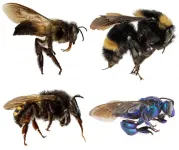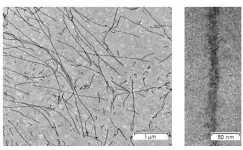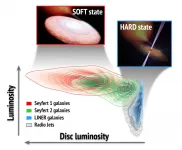Ultrafast, on-chip PCR could speed diagnosis during current and future pandemics
2021-05-26
(Press-News.org) Reverse transcription-polymerase chain reaction (RT-PCR) has been the gold standard for diagnosis during the COVID-19 pandemic. However, the PCR portion of the test requires bulky, expensive machines and takes about an hour to complete, making it difficult to quickly diagnose someone at a testing site. Now, researchers reporting in ACS Nano have developed a plasmofluidic chip that can perform PCR in only about 8 minutes, which could speed diagnosis during current and future pandemics.
Rapid diagnosis of COVID-19 and other highly contagious viral diseases is important for timely medical care, quarantining and contact tracing. Currently, RT-PCR -- which uses enzymes to reverse transcribe tiny amounts of viral RNA to DNA, and then amplify the DNA so that it can be detected by a fluorescent probe -- is the most sensitive and reliable diagnostic method. But because the PCR portion of the test requires 30-40 cycles of heating and cooling in special machines, it takes about an hour to perform, and samples must typically be sent away to a lab, meaning that a patient usually has to wait a day or two to receive their diagnosis. Ki-Hun Jeong and colleagues wanted to develop a plasmofluidic PCR chip that could quickly heat and cool miniscule volumes of liquids, allowing accurate point-of-care diagnosis in a fraction of the time.
The researchers devised a postage stamp-sized polydimethylsiloxane chip with a microchamber array for the PCR reactions. When a drop of sample is added to the chip, a vacuum pulls the liquid into the microchambers, which are positioned above glass nanopillars with gold nanoislands. Any microbubbles, which could interfere with the PCR reaction, diffuse out through an air-permeable wall. When a white LED is turned on beneath the chip, the gold nanoislands on the nanopillars quickly convert light to heat, and then rapidly cool when the light is switched off. The researchers tested the device on a piece of DNA containing a SARS-CoV-2 gene, accomplishing 40 heating and cooling cycles and fluorescence detection in only 5 minutes, with an additional 3 minutes for sample loading. The amplification efficiency was 91%, whereas a comparable conventional PCR process has an efficiency of 98%. With the reverse transcriptase step added prior to sample loading, the entire testing time with the new method could take 10-13 minutes, as opposed to about an hour for typical RT-PCR testing. The new device could provide many opportunities for rapid point-of-care diagnostics during a pandemic, the researchers say.
INFORMATION:
The authors acknowledge funding from the Korea Advanced Institute of Science and Technology (KAIST) and the National Research Foundation of Korea.
The paper is freely available as an ACS AuthorChoice article here.
The American Chemical Society (ACS) is a nonprofit organization chartered by the U.S. Congress. ACS' mission is to advance the broader chemistry enterprise and its practitioners for the benefit of Earth and all its people. The Society is a global leader in promoting excellence in science education and providing access to chemistry-related information and research through its multiple research solutions, peer-reviewed journals, scientific conferences, eBooks and weekly news periodical Chemical & Engineering News. ACS journals are among the most cited, most trusted and most read within the scientific literature; however, ACS itself does not conduct chemical research. As a leader in scientific information solutions, its CAS division partners with global innovators to accelerate breakthroughs by curating, connecting and analyzing the world's scientific knowledge. ACS' main offices are in Washington, D.C., and Columbus, Ohio.
To automatically receive news releases from the American Chemical Society, contact newsroom@acs.org.
Follow us: Twitter | Facebook
[Attachments] See images for this press release:

ELSE PRESS RELEASES FROM THIS DATE:
2021-05-26
Adults with schizophrenia have an elevated risk of dying from suicide. Yet there's only limited understanding of when and why people with schizophrenia die of suicide --in part because research studies have looked at relatively small groups of patients.
Now a new study from Columbia that looked at a large population of adults diagnosed with schizophrenia has found the youngest group (18-34) had the highest suicide risk and those aged 65 and older had the lowest. By comparison, in the general U.S. population, younger adults have less risk and older age groups have greater risk.
The Columbia study, published online May 26 in the journal JAMA Psychiatry, (LINK TK) also showed that people with schizophrenia, overall, have a 4.5-fold increased risk of dying from suicide, ...
2021-05-26
When enjoying a chocolate bar, most people don't think about how the molecules within it are organized. But different arrangements of the fats in chocolate can influence its taste and texture. Now, researchers reporting in ACS' Crystal Growth & Design have found that the side of a chocolate bar facing the mold has a more orderly crystalline structure than the side facing air, knowledge that might help chocolatiers produce tastier confections, the researchers say.
Chocolate is a mixture of cocoa solids, cocoa butter, sugar and other ingredients that interact with each other in complex ways. In particular, the fat molecules, or triacylglycerols, can remain liquid or crystallize into several phases with different melting points. ...
2021-05-26
Several indicators point to the adverse impacts of climate change on the planet’s vegetation, but a little-known positive fact is the existence of climate-change refugia in which trees are far less affected by the gradual rise in temperatures and changing rainfall regimes. Climate-change refugia are areas that are relatively buffered from climate change, such as wetlands, land bordering water courses, rocky outcrops, and valleys with cold-air pools or inversions, for example.
A study conducted in Peruaçu Caves National Park in the state of Minas Gerais, Brazil, with FAPESP’s support, confirmed and quantified ...
2021-05-26
A mathematical model which can predict landslides that occur unexpectantly has been developed by two University of Melbourne scientists, with colleagues from GroundProbe-Orica and the University of Florence.
Professors Antoinette Tordesillas and Robin Batterham led the work over five years to develop and test the model SSSAFE (Spatiotemporal Slope Stability Analytics for Failure Estimation), which analyses slope stability over time to predict where and when a landslide or avalanche is likely to occur.
In a study published in Scientific Reports, ...
2021-05-26
Annapolis, MD; May 26, 2021--A new study has mounted perhaps the most intricate, detailed look ever at the diversity in structure and form of bees, offering new insights in a long-standing debate over how complex social behaviors arose in certain branches of bees' evolutionary tree.
Published today in Insect Systematics and Diversity, the report is built on an analysis of nearly 300 morphological traits in bees, how those traits vary across numerous species, and what the variations suggest about the evolutionary relations between bee species. The result offers strong evidence that complex social behavior developed just once in pollen-carrying bees, rather than twice or more, separately, in different evolutionary branches--but ...
2021-05-26
Travelling elephants pay close attention to scent trails of dung and urine left by other elephants, new research shows.
Scientists monitored well-used pathways and found that wild African savannah elephants - especially those travelling alone - were "highly attentive", sniffing and tracking the trail with their trunks.
This suggests these scents act as a "public information resource", according to researchers from the University of Exeter and Elephants for Africa.
More research is now needed to find out whether humans can create artificial elephant trails to divert elephants away from farms and villages, where conflict with humans can cause devastation to communities.
Alternatively, scent trails could be placed to improve the efficiency of routes ...
2021-05-26
HOUSTON - Researchers at The University of Texas MD Anderson Cancer Center have discovered a novel function for the metabolic enzyme medium-chain acyl-CoA dehydrogenase (MCAD) in glioblastoma (GBM). MCAD prevents toxic lipid buildup, in addition to its normal role in energy production, so targeting MCAD causes irreversible damage and cell death specifically in cancer cells.
The study was published today in Cancer Discovery, a journal of the American Association for Cancer Research. Preclinical findings reveal an important new understanding of metabolism in GBM and support the development of MCAD inhibitors as a novel treatment strategy. The researchers currently are working to develop targeted therapies against the enzyme.
"With ...
2021-05-26
Alzheimer's disease is the most common neurodegenerative disorder in which neurons gradually die off, leading to dementia. The exact mechanism and causes of this disorder have not yet been identified. However, it is known that amyloid plaques form in the brains of patients. Plaques consist of amyloid fibrils, which are special filamentous assemblies formed by amyloid proteins.
'The number of patients with neurodegenerative disorders will continue to grow in the future. Thanks to the success of humanity in the treatment of cancer and cardiovascular diseases, more and more people are living into their 80s. At this age, the risk of developing neurodegenerative disorders, including Alzheimer's disease, becomes very high. Unfortunately, no cures for these diseases have yet ...
2021-05-26
Killer flies can reach accelerations of over 3g when aerial diving to catch their prey - but at such high speeds they often miss because they can't correct their course.
These are the findings of a study by researchers at the Universities of Cambridge, Lincoln, and Minnesota, published today in the Journal of the Royal Society Interface.
Killer flies (Coenosia attenuata) perform high-speed aerial dives to attack prey flying beneath them, reaching impressive accelerations of up to 36 m/s2, equivalent to 3.6 times the acceleration due to gravity (or 3.6g). This happens because they beat their wings as they fall, combining the acceleration of powered flight with the acceleration of gravity.
This is an impressive feat: diving Falcons, the fastest animals that predate ...
2021-05-26
The researchers Juan A. Fernández-Ontiveros, of the Istituto Nazionale di Astrofisica (INAF) in Rome and Teo Muñoz-Darias, of the Instituto de Astrofísica de Canarias (IAC), have written an article in which they describe the different states of activity of a large sample of supermassive black holes in the centres of galaxies. They have classified them using the behaviour of their closest "relations", the stellar mass black holes in X-ray binaries. The article has just been published in the journal Monthly Notices of the Royal Astronomical Society (MNRAS).
Black holes range in mass from objects which have only a few ...
LAST 30 PRESS RELEASES:
[Press-News.org] Ultrafast, on-chip PCR could speed diagnosis during current and future pandemics






